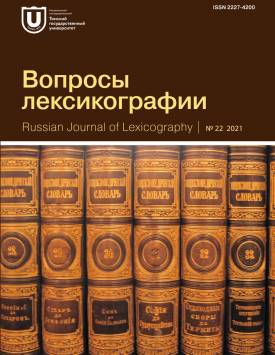A Mid-18th-Century Anonymous Slavic-Latin-German Lexicon from the Collection of the Library of the Russian Academy of Sciences: Principles of Compiling the Glossary
The article solves the problem of the place of an anonymous handwritten Russian-Latin-German lexicon from the collection of the Library of the Russian Academy of Sciences in the history of Russian lexicography. The lexicon has three volumes and was created in the 1750s-1760s - in the period little known in historical Russian studies that precedes the creation of the Dictionary of the Russian Academy. To solve the problem, two types of analysis were used: at the first (preliminary) stage, a structural analysis of dictionary entries of the lexicon was carried out with the identification of types that differ in the configuration of the dictionary entry; at the second stage, a comparative analysis was carried out - the anonymous lexicon was compared with the German-Latin dictionaries indicated by the anonymous author in the preface. In the course of the study, information was obtained about a number of characteristic features in the organization of the glossary of the Russian part of the anonymous lexicon. The main way to replenish the glossary was the translation of the German and Latin words of the foreign language dictionary. The dependence on the German part is most clearly manifested in the definitions of the encyclopedic type, which are given for individual words. All the noted definitions of this type repeat, with minor deviations, the German part of one of the dictionaries mentioned by the anonymous author in the preface. In addition, different types of lexical repetitions in the Russian part of the lexicon testify to the secondary nature of the Russian glossary. The first type of repetitions is several dictionary entries for different meanings of the same lexeme; in this case, the Latin-German correspondences in each of the entries are different. This feature is found in a number of Russian translation dictionaries of the first third of the 18th century. The second, more frequent type of repetitions is the duplication of a verb lexeme with a choice of different initial forms (infinitive and 1-person singular present tense). This is due to the different tradition of designating the initial form in Latin and German lexicography: among the sources of the anonymous lexicon were both Latin-German and German-Latin dictionaries. The translational nature of the Russian part of the dictionary is also indicated by frequent examples in which the title of a dictionary entry is a phrase, and in some cases a whole expanded syntagma corresponding to a lexeme in one of the foreign language parts. Along with this, the author used Slavic printed dictionaries. Possibly, when designing the headings, the author was guided by the pre-Petrine dictionary tradition: the included pronunciation variants of a number of lexemes reflecting colloquial akanye and the use of titlo spellings as headings allow speaking about this. The analysis made it possible to conclude that, according to the principles of compilation, the considered Russian-Latin-German lexicon is a transitional type from translation multilingual to explanatory dictionaries, typical for the initial stage of preparation of large academic dictionary projects, which preceded the release of the Dictionary of the Russian Academy.
Keywords
history of lexicography, translation dictionaries, handwritten lexicon, Russian-Latin-German dictionaryAuthors
| Name | Organization | |
| Molkov Georgiy A. | Institute for Linguistic Studies of the Russian Academy of Sciences | georgiymolkov@gmail.com |
References

A Mid-18th-Century Anonymous Slavic-Latin-German Lexicon from the Collection of the Library of the Russian Academy of Sciences: Principles of Compiling the Glossary | Voprosy leksikografii – Russian Journal of Lexicography. 2021. № 22. DOI: 10.17223/22274200/22/3
